Staff properties
The Staff Properties dialog allows you to make changes to the display of a staff, adjust its tuning and transposition, change instrument etc. To open:
- Right-click on a staff and select Staff Properties....
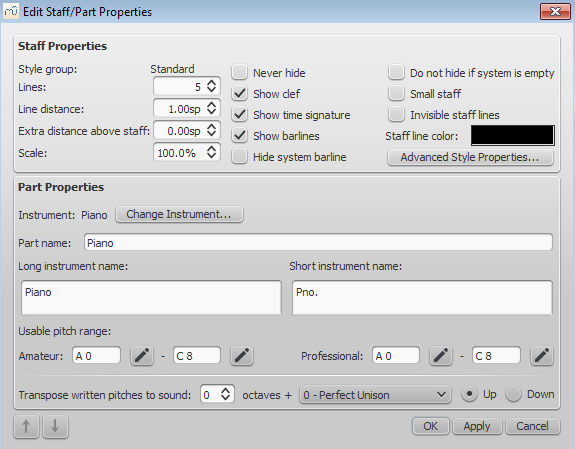
Staff Properties dialog, as of version 2.1.
Staff Types
For practical purposes, there are four different types of staff:
1a. Standard staff I. A pitched staff used for most instruments except fretted, plucked-string ones.
1b. Standard staff II. A pitched staff containing a fretted, plucked-string instrument, with options to set the number of instrument strings and tuning.
2. Tablature staff. A staff containing a fretted, plucked-string instrument, which displays music as a series of fret-marks on strings. Also contains options to set the number of instrument strings and tuning.
3. Percussion staff. A pitched staff for percussion instruments.
It is possible to change one type of staff into another using the Instruments dialog, as long as the original staff is loaded with the right instrument. For example, in order to change a standard staff to tablature, it must contain a plucked-string instrument. Similarly, to change a standard staff to a percussion staff you need to ensure that it has an appropriate percussion instrument loaded and so on.
Most options in the Staff properties dialog are common to all staves, but each type also has one or two specific options of its own.
Staff Properties: all staves
The following Staff Properties options are common to all staves:
Lines
The number of lines making up the staff.
Line Distance
The distance between two staff lines, measured in spaces (abbr.: sp). If you set this to a higher value, the lines are spaced more widely apart; a lower value and they are closer together. It is not recommended to change this value for the standard group, for which the default distance is 1.0 (instead, change the actual size of the sp unit in 页面设置); other groups may have different default values (for instance, tablature usually has a line distance of 1.5 sp).
Extra distance above staff
Increases or decreases the distance between the selected staff and the one above in all systems. However, it does not apply to the top staff of a system, which is controlled by the minimum/maximum system distance (see Layout and formatting: Style → General... → Page).
Alternatively, you can alter the "Extra distance above staff" directly from the score page:
1. Press and hold the Shift key.
2. Click on an empty space in a staff and drag it up or down with the mouse.
Note: To alter the spacing above just one staff line in a particular system, see Breaks and spacers.
Scale
Changes the size of the selected staff and all associated elements, as a percentage (to adjust the overall score size, use Scaling from the Layout→Page Settings… menu).
Never Hide
Never hide this staff. This overrules any "Hide empty staves" setting in Layout and Formatting: Style → General... → Score.
Show clef
Whether the staff clef will be shown.
Show time signature
Whether the staff time signature(s) will be shown or not.
Show barlines
Whether the staff barlines will be shown.
Hide system barline
Show/hide barline at left-hand edge of the staff.
Do not hide if system is empty
Never hide this staff, even if the entire system is empty. This overrules any "Hide empty staves" setting in Layout and Formatting: Style → General... → Score.
Small staff
Create a reduced-size staff. You can set the default from the menu in Layout and Formatting: Style → General... → Sizes
Invisible staff lines
Make staff lines invisible.
Staff line color
Use a color picker to change the color of the staff lines.
Part name
The name of the part. This is also displayed in the Mixer and the Instruments dialog (I).
Instrument
The instrument loaded in the Instruments (I) or Select Instrument dialog. The sound associated with this instrument can be changed, if desired, in the Mixer.
Long instrument name
Name displayed to the left of the staff in the first system of the score. The long instrument name may also be edited directly as a text object (as of version 2.1): see Text editing.
Short instrument name
Name displayed to the left of the staff in subsequent systems of the score. The short instrument name may also be edited directly as a text object (as of version 2.1): see Text editing. Editing affects all occurrences in the score.
Usable pitch range
- Amateur: Notes outside this range will be colored olive green/dark yellow in the score.
- Professional: Notes outside this range will be colored red in the score.
To disable out-of-range coloration of notes: From the menu, select Edit→Preferences... (Mac: MuseScore→Preferences...), click on the "Note Input" tab, and uncheck "Color notes outside of usable pitch range."
See also, Coloring of notes outside an instrument's range.
Transpose written pitches (as of version 2.1) / Play transposition
This option ensures that the staves of transposing instruments display music at the correct written pitch. Set the transpose in term of a musical interval (plus octave if required) up or down. For plucked-string instruments such as the guitar, this property can be used to create the effect of applying a capo.
Navigation arrows (as of version 2.1)
Use the ↑ and ↓ buttons, at the bottom left of the Staff Properties window, to navigate to the previous or next staff.
Staff Properties: plucked strings only
Staves of fretted, plucked-string instruments have a few extra options in addition to those listed above,
Number of strings
Displays the number of instrument strings.
Edit String Data…
This button opens a dialog box which allows you to set the number and tuning of strings. See Change string tuning.
Advanced Style Properties
Clicking the Advanced Style Properties... button opens a window giving access to advanced display options for the staff. These will vary depending on the staff type chosen: see the relevant sections below for details.
Change staff type
At the bottom of the Advanced Style Properties dialog there are a number of buttons which allow you to easily change the following:
- The number of lines displayed by a percussion staff.
- The staff type of a plucked-string instrument. For example, you can change from standard staff to tablature and vice versa, or select from a number of tablature options.
- Make a selection from the drop-down list labelled "Template";
- Press < Reset to Template;
- Press OK to accept the changes and exit the dialog (or Cancel to cancel the operation).
Standard and Percussion staff options
Show key signature
Whether the staff key signature will be shown.
Show ledger lines
Whether the staff ledger lines will be shown.
Stemless
If checked, staff notes will have no stem, hook or beam.
Tablature staff options
Upside down
If not checked, the top tablature line will refer to the highest string and the bottom tablature line will refer to the lowest string (most common case). If checked, the top tablature line will refer to the lowest string and the bottom tablature line will refer to the highest line (used in Italian style lute tablatures).
Tablature staff options: Fret Marks
Fret marks are the numbers or letters used to indicate the location of notes on the fingerboard. The following group of properties define the appearance of fret marks:
Font
The font used to draw fret marks. As of version 2.1, 8 fonts are provided supporting all the necessary symbols in 8 different styles (modern Serif, modern Sans, Renaissance, Phalèse, Bonneuil-de Visée, Bonneuil-Gaultier, Dowland, Lute Didactic).
Size
Font size of fret marks in typographic points. Built-in fonts usually look good at a size of 9-10pt.
Vertical offset
MuseScore tries to place symbols in a sensible way and you do not usually need to alter this value (set to 0) for built-in fonts. If the font has symbols not aligned on the base line (or in some other way MuseScore does not expect), this property allows you to move fret-marks up (negative offsets) or down (positive offsets) for better vertical positioning. Values are in sp.
Numbers / Letters
Whether to use numbers (‘1’, ‘2’...) or letters (‘a’, ‘b’...) as fret marks. When letters are used, ‘j’ is skipped and ‘k’ is used for the 9th fret.
On lines / Above lines
Whether marks should be placed on the string lines or above them.
Continuous / Broken
Whether string lines should pass ‘through’ fret marks or should stop at them.
Example of numbers on broken lines:
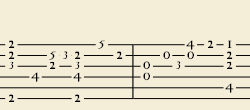
Example of letters above continuous lines:
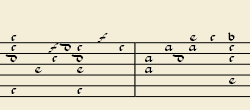
Example of 'upside down' tablature (same contents as number example above):

Show back-tied fret marks
If unticked, only the first note in a series of tied notes is displayed. If ticked, all notes in the tied series are displayed.
Show fingerings
From version 2.1, tick to allow the display of fingering symbols applied from a palette.
Tablature staff options: Note Values
This group of properties defines the appearance of the symbols indicating note values.
Font
The font used to draw the value symbols. Currently 5 fonts are provided supporting all the necessary symbols in 5 different styles (modern, Italian tablature, French tablature, French baroque (headless), French baroque). Used only with the Note symbols option.
Size
Font size, in typographic points. Built-in fonts usually look good at a size of 15pt. Used only with the Note symbols option.
Vertical offset
Applies only when Note symbols is selected (see below). Use negative offset values to raise the note value symbols, positive values to lower them.
Shown as:
- None: No note value will be drawn (as in the examples above)
- Note symbols: Symbols in the shape of notes will be drawn above the staff. When this option is selected, symbols are drawn only when the note value changes, without being repeated (by default) for a sequence of notes all of the same value. E.g.
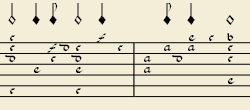
- Stems and beams: Note stems and beams (or hooks) will be drawn. Values are indicated for each note, using the same typographic devices as for a regular staff; all commands of the standard Beam Palette can be applied to these beams too. E.g.
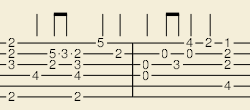
Repeat:
If several notes in sequence have the same duration, you can specify if and where to repeat the same note symbol. i.e.
- Never
- At new system
- At new measure
- Always
Note: This option is only available if "Shown as: Note symbols" is selected (see above).
Stem style:
- Beside staff: Stems are drawn as fixed height lines above/below the staff.
- Through staff: Stems run through the staff to reach the fret marks.
Note: This option is only available when "Shown as: Stems and Beams" is selected (see above).
Stem position:
- Above: Stems and beams are drawn above the staff.
- Below: Stems and beams are drawn below the staff.
Note: This option is only available when "Shown as: Stems and Beams" and "Stem style: Beside staff" is selected (see above).
Half notes:
- None
- As short stems
- As slashed stems
Note: This option is only available when "Shown as: Stems and Beams and "Stem style: Beside staff" is selected (see above).
Show rests
Whether note symbols should be used to indicate also the rests; when used for rests, note symbols are drawn at a slightly lower position. Used only with the Note symbols option.
Preview
Displays a short score in tablature format with all the current parameters applied.
Change instrument
You can change any instrument in a score to a different instrument at any time. The following method updates instrument sound, staff name, and staff transposition all at once.
- Right-click on an empty part of any measure OR on the instrument name and choose Staff Properties...;
- Click on Change Instrument... (under "Part Properties");
- Choose your new instrument and click OK to return to the Staff Properties dialog;
- Click OK again to return to the score.
Not to be confused with Mid-staff instrument change.